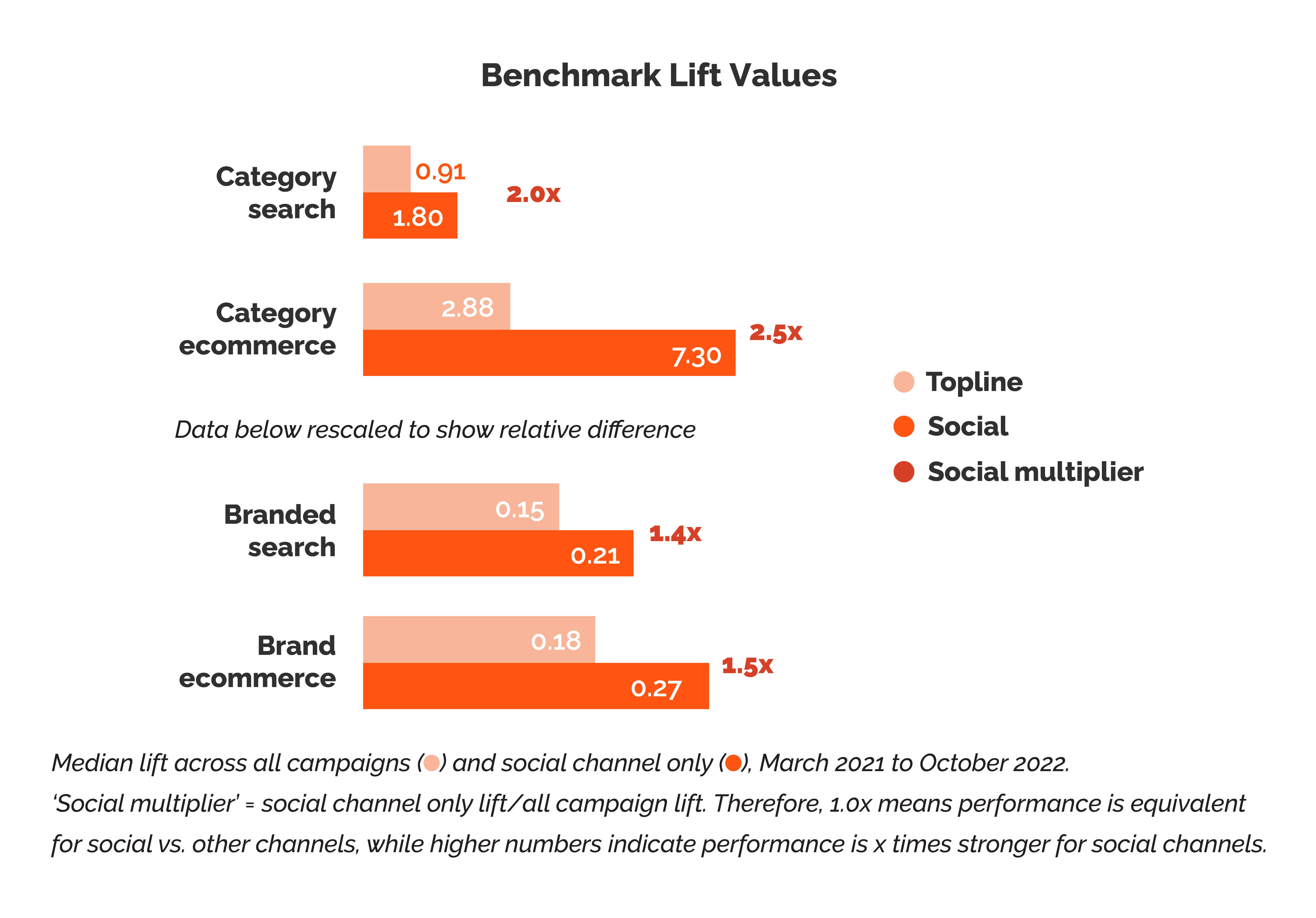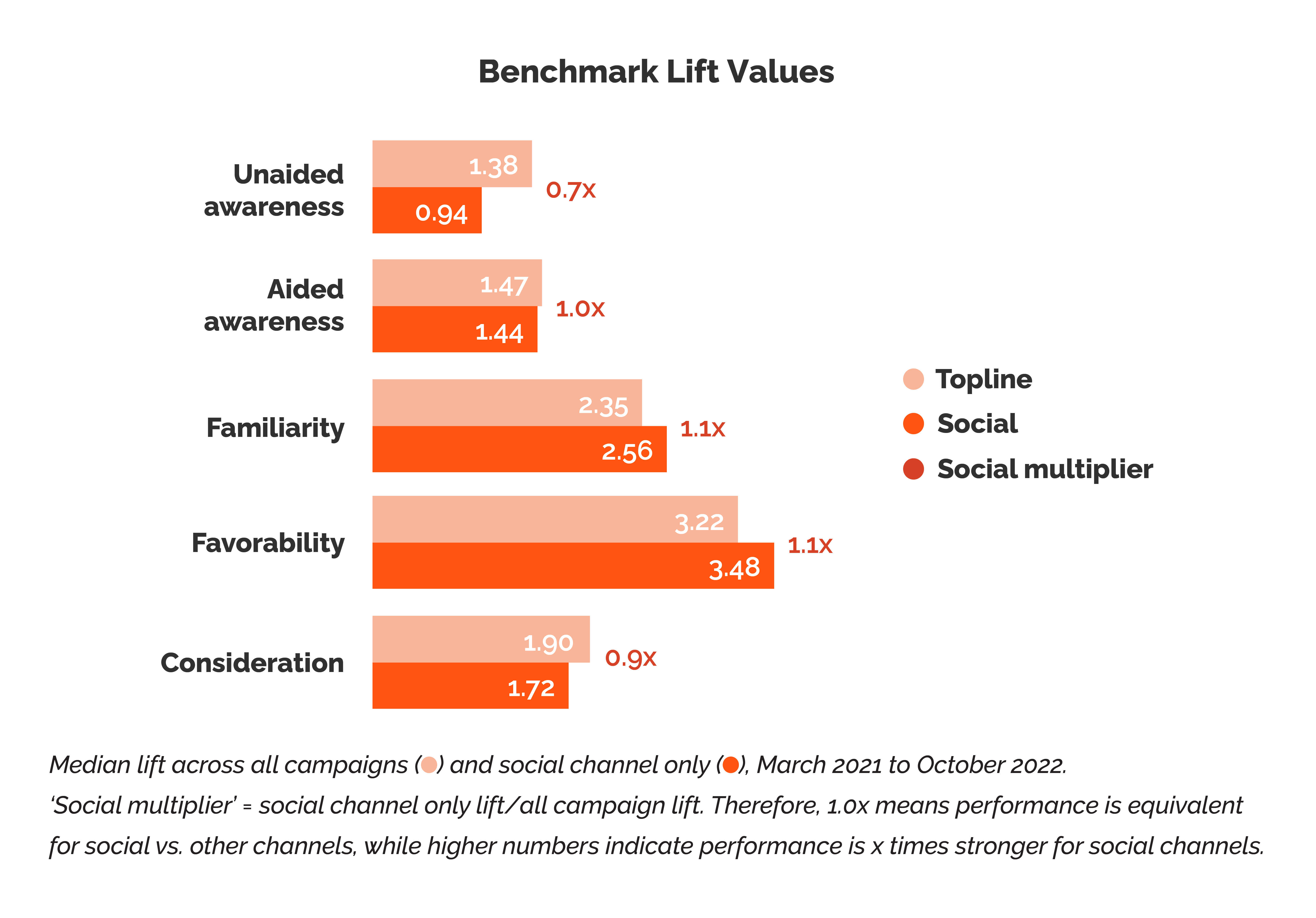Social media advertising benchmarks
Patrick Egan Ph.D
12/7/22 11:32 AM

It’s no secret that social media advertising has exploded in popularity over the past 10+ years. With its immense scale, engaging content, and youthful appeal, social media marketing allows advertisers to get directly ‘in front’ of digital-first consumers in a way that few other platforms can. Given these inherent advantages, spend on social media ad campaigns has increased over 300% in the past 5 years.
For marketers and their partners, the explosive growth in social media advertising immediately prompts a crucial question: are these rapidly-increasing investments in social media justified by downstream performance data? Put another way, are social KPIs high enough relative to other channels to push one’s marketing strategy further towards social media for specific use cases?
There’s certainly no easy way to answer this question. But with enough data, a highly diverse set of ad campaigns, and an unbiased measurement approach, DISQO can shed some much-needed light. Using hundreds of ad campaigns tested with clients by our Brand Lift and Outcomes Lift products, we can build normative benchmarks for various exposure channels - like social media - and compare them against one another to determine relative effectiveness.
But not all benchmarks are created equal, and marketers need to have a keen understanding of which benchmark data they choose to leverage when forming large-scale conclusions about ad performance. This is especially true in the realm of social media, where benchmarks are often maintained / published by the social platform itself, introducing the potential for bias and heavily-siloed insights.
Among other aspects, benchmarks for social media ad effectiveness should be:

For marketers and their partners, the explosive growth in social media advertising immediately prompts a crucial question: are these rapidly-increasing investments in social media justified by downstream performance data? Put another way, are social KPIs high enough relative to other channels to push one’s marketing strategy further towards social media for specific use cases?
There’s certainly no easy way to answer this question. But with enough data, a highly diverse set of ad campaigns, and an unbiased measurement approach, DISQO can shed some much-needed light. Using hundreds of ad campaigns tested with clients by our Brand Lift and Outcomes Lift products, we can build normative benchmarks for various exposure channels - like social media - and compare them against one another to determine relative effectiveness.
The value of social media normative benchmarks
Normative benchmarks are critical for accurately evaluating advertising effectiveness within social media channels. Benchmarks allow advertisers to compare performance between different types of campaigns, enabling objective inferences about how ads fare based on the exposure channel (i.e., social, CTV/OTT, digital display, etc.).But not all benchmarks are created equal, and marketers need to have a keen understanding of which benchmark data they choose to leverage when forming large-scale conclusions about ad performance. This is especially true in the realm of social media, where benchmarks are often maintained / published by the social platform itself, introducing the potential for bias and heavily-siloed insights.
Among other aspects, benchmarks for social media ad effectiveness should be:
Full-funnel: Benchmarks for any channel - social media or otherwise - need to have coverage across both attitudinal and behavioral metrics to have optimal value. While many platforms inherent rely upon brand lift (i.e., how exposure impacts awareness, favorability, or other brand attitudes), solutions that also assess behavioral lift (i.e., how exposure impacts search, site visitation, or e-commerce) ensure you’re seeing the full picture of an ad’s impact. Benchmarks that cover diverse metrics make campaign evaluation more reliable, efficient, and valuable for your organization.

Cross-channel: Benchmarks for social media advertising campaign performance should be comparable to other non-social channels like open web, CTV/OTT, etc. If the same underlying research methodology is used to measure ad effectiveness for these diverse channels, subsequent benchmarks become infinitely more comparable. Marketers can contrast social media performance against other platforms in an apples-to-apples format that drives maximal incremental knowledge. While certain channels may naturally have an advantage due to certain features (e.g., brand fit, spend allocation, campaign tone), the ability to compare across channels can validate or refine your placement strategy.

Future-proof: Consumer protections have made measuring ad effectiveness on social media increasingly difficult in recent years. Marketers should ensure that their ad effectiveness benchmarks do not rely upon ‘cookie-like’ technology or outdated IP addresses, as these techniques will be a relic of the past while consumers increasingly push back on universal tracking. Having benchmarks that are built on opt-in, fully-consented consumer data - which comes directly from consumers willing to share - gives advertisers the best avenue to continually assess ad effectiveness going forward. Relying on more antiquated tracking technologies may leave your benchmarks in the proverbial dust.
At DISQO, we’ve built technology and systems that meet these challenging criteria, making our benchmark data extremely valuable when analyzing the impact of social ad campaigns. Critically, we can also delineate those benchmarks by key campaign features - like placement channel - to analyze where and when certain ads are maximally-effective.
Below, we leverage our proprietary benchmark data to explore how social media advertising compares to other channels in terms of its impact on top-of-funnel brand attitudes and bottom-of-funnel brand behaviors. We then outline a few key insights from this analysis, all of which are discussed in detail within our larger downloadable report.
Analysis approach
In the forthcoming analysis, we leverage benchmark data in two distinct formats. By assessing the difference between these two formats, we can identify the unique effects of social media advertising.
1. ‘Topline’ benchmarks utilize all ad campaigns in our database irrespective of display channel (OTT/CTV, digital display, mobile, streaming audio, social media).

2. ‘Social’ benchmarks utilize only the portions of social media marketing campaigns run on platforms such as Facebook, Instagram, Pinterest, Reddit, Snapchat, TikTok, and Twitter.

Upon producing these benchmarks, our primary index of social media effectiveness is the ‘social multiplier’ - a simple index that divides the social benchmark (i.e., social media ads only) by the topline benchmark (i.e., all ads irrespective of channel). When this multiplier value is ‘1.0’, social media advertising performs at parity with other channels. However, when the multiplier moves notably higher/lower, we can infer that social media advertising is ‘x times’ stronger/weaker than other channels.

A look below at these ‘social multiplier’ values from our Outcomes Lift metrics highlights the potential advantages for social media advertising. Whether we consider category-level behaviors (i.e., not specific to the client’s brand) or brand-level behaviors (i.e., focused on the client's specific brand), there is a notable advantage for social media channels in terms of behavioral advertising impact / conversion indicators.

For example, let’s look at category search, which refers to digital search for the larger brand category or unbranded terms within a dedicated search engine. For this metric, the benchmark for topline lift is 0.9 points, but the benchmark for social lift is 1.8 points. As such, ads on social channels elicit a behavioral response that is twice as strong as the ‘average’ digital channel, driving consumers to investigate the product category further as they get closer to purchase. Similar findings are seen for e-commerce actions, where social channels generate a consumer response that is 1.5-2.5x stronger than the topline benchmark.
Ultimately, regardless of the behavioral metric you look at, social media ads drive more powerful outcomes than the average digital channel. While this does not necessarily mean they will always drive stronger results - because benchmarks are median values with meaningful variability - it does imply that the average social media ad will outperform a similar ad on digital display, streaming audio, CTV/OTT, etc. across key conversion behaviors.
With such consistently powerful behavioral results, advertisers should always consider social media ads when focused on driving discrete consumer actions - particularly those that are digital in nature (e.g., search, site visitation, e-commerce).

As you can quickly see in the above chart, differences by channel are now very muted. Across diverse attitudinal metrics like awareness, familiarity, favorability, and consideration, we see that social ads do not outperform topline benchmarks. Their social multiplier values are in the range of 0.9 to 1.1, effectively performing at parity to ads within other digital channels.
Does this mean that social media ads are equivalent to other digital channels in terms of their ability to lift brand attitudes? Not necessarily.
In sum, advertisers focused on moving awareness, or brand sentiment may be less motivated to over-leverage social media ads. These ads come with significant planning, execution, and platform costs, and if other digital channels can generate similar attitudinal results, it may behoove marketers to allocate less spend to social. While they can generate very positive behavioral conversion, the potential of social media ads are more constrained at the top of the brand funnel.
At DISQO, we’ve built technology and systems that meet these challenging criteria, making our benchmark data extremely valuable when analyzing the impact of social ad campaigns. Critically, we can also delineate those benchmarks by key campaign features - like placement channel - to analyze where and when certain ads are maximally-effective.
Below, we leverage our proprietary benchmark data to explore how social media advertising compares to other channels in terms of its impact on top-of-funnel brand attitudes and bottom-of-funnel brand behaviors. We then outline a few key insights from this analysis, all of which are discussed in detail within our larger downloadable report.
Analysis approach
In the forthcoming analysis, we leverage benchmark data in two distinct formats. By assessing the difference between these two formats, we can identify the unique effects of social media advertising. 1. ‘Topline’ benchmarks utilize all ad campaigns in our database irrespective of display channel (OTT/CTV, digital display, mobile, streaming audio, social media).
2. ‘Social’ benchmarks utilize only the portions of social media marketing campaigns run on platforms such as Facebook, Instagram, Pinterest, Reddit, Snapchat, TikTok, and Twitter.
Upon producing these benchmarks, our primary index of social media effectiveness is the ‘social multiplier’ - a simple index that divides the social benchmark (i.e., social media ads only) by the topline benchmark (i.e., all ads irrespective of channel). When this multiplier value is ‘1.0’, social media advertising performs at parity with other channels. However, when the multiplier moves notably higher/lower, we can infer that social media advertising is ‘x times’ stronger/weaker than other channels.
Biggest winners = bottom of funnel conversion behaviors
A look below at these ‘social multiplier’ values from our Outcomes Lift metrics highlights the potential advantages for social media advertising. Whether we consider category-level behaviors (i.e., not specific to the client’s brand) or brand-level behaviors (i.e., focused on the client's specific brand), there is a notable advantage for social media channels in terms of behavioral advertising impact / conversion indicators.

For example, let’s look at category search, which refers to digital search for the larger brand category or unbranded terms within a dedicated search engine. For this metric, the benchmark for topline lift is 0.9 points, but the benchmark for social lift is 1.8 points. As such, ads on social channels elicit a behavioral response that is twice as strong as the ‘average’ digital channel, driving consumers to investigate the product category further as they get closer to purchase. Similar findings are seen for e-commerce actions, where social channels generate a consumer response that is 1.5-2.5x stronger than the topline benchmark.
Ultimately, regardless of the behavioral metric you look at, social media ads drive more powerful outcomes than the average digital channel. While this does not necessarily mean they will always drive stronger results - because benchmarks are median values with meaningful variability - it does imply that the average social media ad will outperform a similar ad on digital display, streaming audio, CTV/OTT, etc. across key conversion behaviors.
With such consistently powerful behavioral results, advertisers should always consider social media ads when focused on driving discrete consumer actions - particularly those that are digital in nature (e.g., search, site visitation, e-commerce).
- While social media may not be as differentiated from other channels when it comes to attitudinal impact (see next section), it is highly differentiated on critical digital actions that predict purchase behavior.
- If marketers have leftover budget for the holidays or a need to allocate certain spend to specific sales outcomes, social media represents a strong default option.
Smallest winners = top of funnel attitudes
In contrast to the behavioral outcomes discussed previously, social media ads are not as strongly differentiated on attitudinal outcomes. Below, we chart the topline and social lift for five core brand metrics, starting with top-funnel awareness all the way down to mid-funnel consideration. To the right, you’ll again see social multiplier values, highlighting the relative performance of social media channels compared to topline campaign results.
As you can quickly see in the above chart, differences by channel are now very muted. Across diverse attitudinal metrics like awareness, familiarity, favorability, and consideration, we see that social ads do not outperform topline benchmarks. Their social multiplier values are in the range of 0.9 to 1.1, effectively performing at parity to ads within other digital channels.
Does this mean that social media ads are equivalent to other digital channels in terms of their ability to lift brand attitudes? Not necessarily.
- The benchmark we’re focusing on here are inherently summary statistics that focus on what ‘typical’ campaign performance looks like. As such, their aggregated nature shrouds some of the variability that exists within any channel.
- There are certainly cases where social media ads are demonstrably better or worse than other channels in terms of driving awareness, consideration, and myriad other brand metrics. But on average, from the hundreds of campaigns available within our normative database, the differentiating power of social media ads are less notable at the top of the brand funnel.
In sum, advertisers focused on moving awareness, or brand sentiment may be less motivated to over-leverage social media ads. These ads come with significant planning, execution, and platform costs, and if other digital channels can generate similar attitudinal results, it may behoove marketers to allocate less spend to social. While they can generate very positive behavioral conversion, the potential of social media ads are more constrained at the top of the brand funnel.
There’s more where that came from in our social media advertising benchmarks report
The analysis presented here is a small sampling of what’s available in our larger report on social media benchmarks. In this report - available for download now - marketers can dive into:- Social media benchmarks for other Brand and Outcomes metrics
See social multipliers for all 14 metrics we benchmark, alongside benchmarks for topline and social media separately
- Industry-level comparisons of social vs. topline benchmarks
Explore how consumables, goods, and services advertising performance differs when leveraging social media channels
- Campaign-level comparisons between social and topline lift
Learn what percentage of individual campaigns have stronger / weaker lift performance on social channels
- Distributional analyses of how large/small social media advantages are
Identify the instances where social media advertising campaigns exponentially exceed that of other channels, and where it doesn’t
Interested in learning more about DISQO’s social media advertising performance benchmarks?

Subscribe now!
Get our new reports, case studies, podcasts, articles and events

